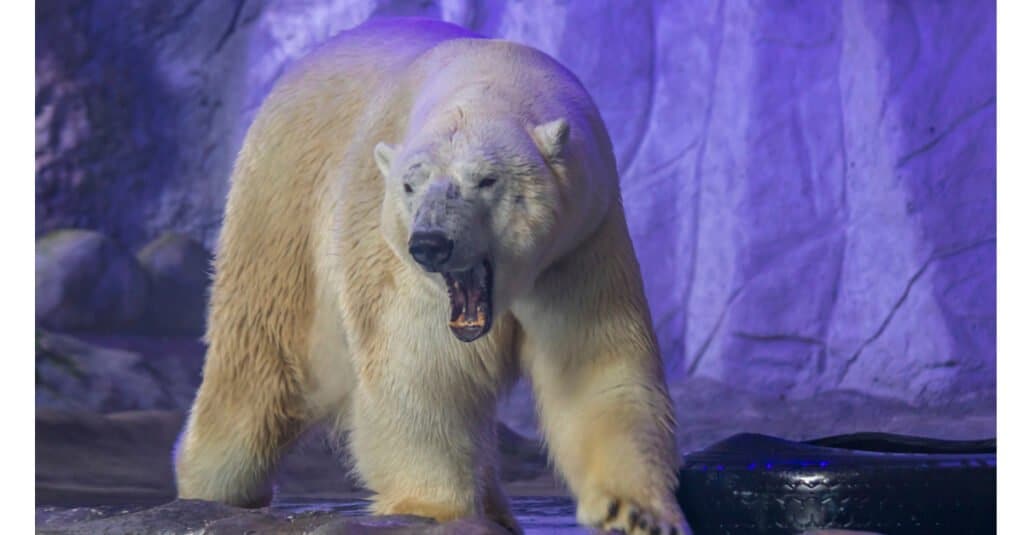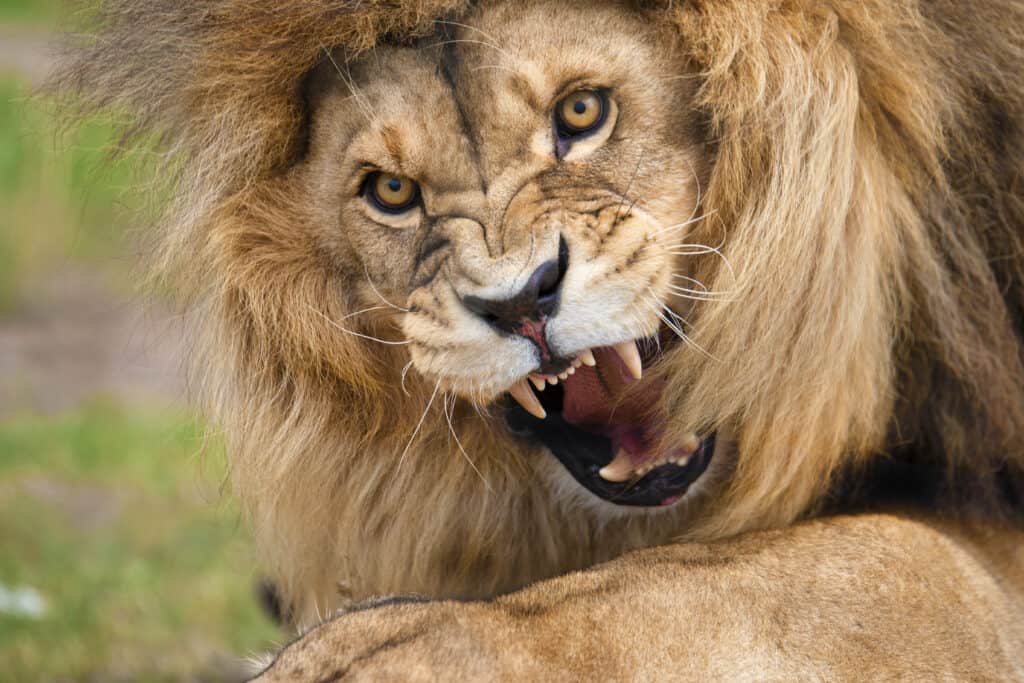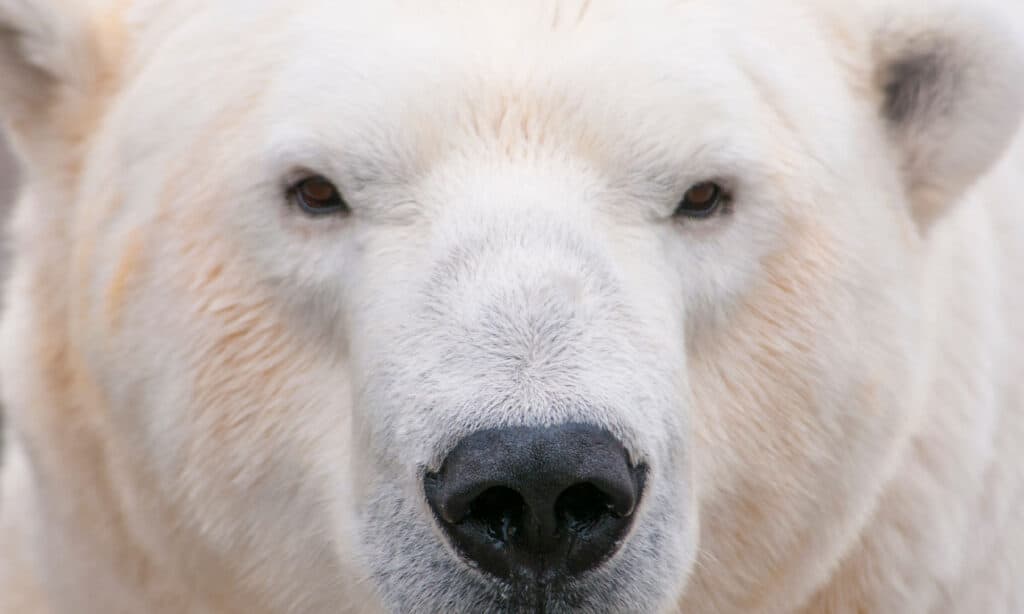It’s another epic animal battle! A polar bear vs. lion fight!
Polar bears are expert hunters, capable of stalking a single seal for hours. Sitting patiently on the ice, they wait by the seal’s breathing hole. The second the animal comes up for air, the polar bear will snag them with their long sharp claws!
Lions are also ambush hunters with the ability to wear out their prey. Using endurance tactics, lions can exhaust prey during the pursuit, making it easier to land the kill. These big cats have mastered the art of the slow strangulation hold.
What happens when the ruler of the Arctic goes up against the king of the jungle? Read on to find out!
Polar Bear vs. Lion Comparison Chart
| Battle Factors | Polar Bear | Lion |
|---|---|---|
| Size | 5 to 8 feet tall 8 to 10 feet in length 600 to 1300 pounds | 3 to 4 feet tall 8 to 10 feet in length 330 to 550 pounds |
| Speed | 25 mph | 50 mph |
| Carnivorous Behaviors | Ambush hunter Polar bears are capable of flexible foraging strategies. Prefer stalking ringed and bearded seals Snatches prey out of water | Ambush hunter Collaborative hunt High-speed pursuits Fatal pounce Clamps jaws around prey’s throat |
| Top Advantages | Bite force more powerful than great white shark Lifts over 1,000 pounds Arctic experts | Retractable claws snare prey Night vision Savannas and Grassland experts |
The key factors in this animal battle will be size and speed, attack abilities, and lifestyle. The polar bear and lion are both carnivorous predators. They’re designed to kill and have different Ambush techniques to take down prey. Lions are one of the big cats, using endurance predation and Ambush strategies. Polar bears use their stealthy skill to seek out seals across the ice. Both fighters have amazing senses that can smell, hear, and see enemies from far away.
The Lion
Our first competitor coming to the ring is the king of the jungle, the lion! As the lion approaches the ring, he announces his presence with an earth-shattering roar. Lions start vocalizing at birth, and by the time they’re adults, you can hear their thunderous roar 5 miles away.
Lions aren’t picky eaters. These opportunistic hunters will eat almost anything if they’re hungry enough. Their diet includes zebras, antelope, ostriches, and even whale carcasses that wash up on the beach.
The Polar Bear

Polar bears can only reach top speeds of 25 miles per hour.
©imperio10/Shutterstock.com
Walking into the fighting ring, it’s clear this bear will be the heavyweight contender. After the Kodiak Brown bear, polar bears are the biggest bear species in the world! They’re also the largest carnivore that lives on land. Seabirds, seals, and even the occasional walrus are on the menu for the mighty polar bear. But how will their appetite and size fare against a ferocious lion?
Lions have savannah smarts, and polar bears have Arctic know-how. Let’s see what happens during the first round when we compare these impressive animals’ size and speed.
Round One: Size and Speed
Round one is all about size and speed! Side by side, the polar bear towers over the lion.
Polar bears are caniform mammals. They stand 5 feet at the shoulder and grow over 8 feet long! On average, these massive bears way around 1300 pounds, with females weighing less.
Our lionhearted competitor weighs about half as much as the polar bear. On average, lions weigh between 250 and 550 pounds. They have an average length of 4.5 to 8 1/2 feet long, with a height of 3 to 4 feet.
Their smaller size and muscular build help lions run much faster than polar bears. Lions can comfortably run at speeds of 35 mph. In short bursts, they can even reach speeds of 50 mph!
Polar bears only reach top speeds of 25 miles per hour, and rarely do they move quickly on land. These large bears must be careful not to overheat; they avoid running whenever possible. On land, polar bears walk with slow lumber and gate and swim through the water at 6 mph.
Round one goes to the lion! The polar bear is much larger than our wildcat competitor. But all of that size slows them down quite a bit. The lion would have the advantage of running circles around the polar bear, causing them to overheat and lose the battle.
Round Two: Attack Abilities

A lion’s claws can grow 1.5 inches; they use them to hold on to their prey as they strangle them to death.
©Shawn Levin/Shutterstock.com
As this animal battle heats up, it’s time for round two; attack abilities. Lions and polar bears have a reputation for being fierce predators in their environment. But who will have what it takes to win in this animal showdown? Let’s start by looking at the tricks the polar bear brings to the fighting ring.
Watch out! The polar bear has a bite force of 1,200 PSI! They can crush through a bowling ball with a single bite. They also have 42 teeth, made for ripping flesh and crunching bones.
If it’s not the bite that takes the win, it’ll be the polar bear’s 4-inch-long curved claws that they use to grab their prey. There are five of these non-retractable claws on each hand. These claws are so sharp they could slice the lion into ribbons.
The lion is also bringing razor-sharp claws to this animal battle. A lion’s claws can grow 1.5 inches; they use them to hold on to their prey as they strangle them to death. They also use their powerful hind legs to pounce on prey as far as 40 feet away.
Once they’re on top of the polar bear, the lion can try severing the bear’s spinal cord with a big bite. Lions have sharp 3-inch long incisors that look like fangs.
If severing the spinal cord doesn’t work, the lion might try going for the throat. But the first attempt might not stick. When hunting, lions only successfully make a kill about 30% of the time. So, the polar bear will have a good chance of escaping.
Round two is a tie. Both of our competitors have impressive claws and teeth. They’re so remarkable that it’s hard for either animal to gain an advantage.
Round Three: Lifestyle

Polar bears are solitary creatures.
©iStock.com/ElliotHurwitt
The final round of our animal battle is all about social skills. The way these animals live their lives will be the determining factor in who wins this fight.
Polar bears are solitary creatures. The scientific name for a polar bear is Ursus maritimus, which translates to Sea Bear. These sea bears spend most of their lives alone, wandering the arctic. There are an estimated 20,000 polar bears left in existence. They’re one of the few large mammals that can survive the harsh conditions of life on the ice.
Lions are the only cat species that live in a social setting. Groups of lions, or pride, can have over 40 members. However, it’s more common for the numbers to be around four to eight. Usually, there are one or two dominant males, and lionesses comprise the rest.
Round three is a win for the lion! When a polar bear starts to pick a fight with a pride member, the lions will come for support. In moments, it’ll be one bear against multiple angry wild cats, and that’s not easy to walk away from.
And the Winner Is….
The lion is the winner of the animal battle! The winning factor in this fight is that lions live in a group.
Even in a one-on-one fight, the lion stands a good chance of walking away from the champion. Polar bears have great endurance in the water and can swim for miles. But on land, these large bears can get dangerously hot. The animal battle could cause the polar bear to overheat, losing before getting to throw the first blow.
How would the lion take down the polar bear? The lion would quickly wear out the polar bear and then make its final strike. Lions have mastered the art of slow strangulation. The big cat would go for the polar bear’s throat or bite down on the back of the neck. It’d be lights out for the polar bear!
The photo featured at the top of this post is ©
Thank you for reading! Have some feedback for us? Contact the AZ Animals editorial team.






